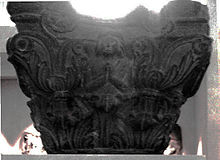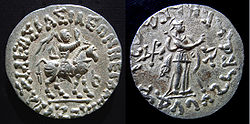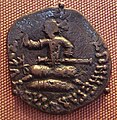Azes II
| Azes II | |
|---|---|
| Indo-Scythian king | |
 Azes II in armour, riding a horse, on one of his silver tetradrachms, minted in Gandhara | |
| Reign | Scythians: perhaps 35–12 BC |
| Predecessor | Azilises |
| Successor | Zeionises/Kharahostes |
Azes II (Greek: Ἄζης Azēs, epigraphically ΑΖΟΥ Azou; Kharosthi: 𐨀𐨩 A-ya, Aya[1]), may have been the last Indo-Scythian king, speculated to have reigned circa 35–12 BCE, in what is Pakistan today. His existence has been questioned; if he did not exist, artefacts attributed to his reign, such as coins, are likely to be those of Azes I.[2]
After the death of Azes II, the rule of the Indo-Scythians in northwestern India and Pakistan finally crumbled with the conquest of the Kushans, one of the five tribes of the Yuezhi who had lived in Bactria for more than a century, and who were then expanding into India to create a Kushan Empire. Soon after, the Parthians invaded from the west. Their leader Gondophares temporarily displaced the Kushans and founded the Indo-Parthian Kingdom that was to last until the middle of the 1st century CE. The Kushans ultimately regained northwestern India circa 75 CE, where they were to prosper for several centuries.
Name
Azes's name is attested on his coins in the Greek form Azēs (Ἄζης) and the Kharosthi form Aya (𐨀𐨩),[1] which are both derived from the Saka name *Aza, meaning "leader".[3]
Buddhist dedications

Bimaran casket

Azes II is also connected to the Bimaran casket, one of the earliest representations of the Buddha. The casket was part of the deposit of Stupa 2 in Bimaran, near Jalalabad in Afghanistan, and placed inside the stupa with several coins of Azes II. This event may have happened during the reign of Azes (35–12 BCE), or slightly later. The Indo-Scythians are otherwise connected with Buddhism (see Mathura lion capital and the multiple Buddhist dedications of the Apracas), and it is indeed possible they would have commended the work. However it now thought that a later king, issuing coins in the name of Azes, such as Kharahostes, made the dedication.
Butkara stupa
A coin of Azes II was found under a pillar with an Indo-Corinthian capital and sculpture of a Buddhist devotee in the Butkara Stupa, suggesting the involvement of Azes II in Buddhist dedications, and a datation for the sculpture corresponding to the reign of Azes II.[4]
Coinage
Coins attributed to Azes II use Greek and Kharoshti inscriptions, depict a Greek goddess as his protector, and thereby essentially follow the numismatic model of the Greek kings of the Indo-Greek kingdom, suggesting a high willingness to accommodate Greek culture. A novel difference of the Indo-Scythians was to show the king on a horse, rather than his bust in profile as did the Greeks.
Other coins of Azes depict the Buddhist lion and the Brahmanic cow of Shiva, suggesting religious tolerance towards his subjects. In the coin depicted to the left Azes is depicted with the inscriptions:

- Obv: King with coat of mail, on horse, holding a sceptre, with Greek royal headband. Greek legend ΒΑΣΙΛΕΩΣ ΒΑΣΙΛΕΩΝ ΜΕΓΑΛΟΥ ΑΖΟΥ "The Great King of Kings Azes".
- Rev: Athena with shield and lance, making a hand gesture identical to the Buddhist vitarka mudra. Kharoshti legend MAHARAJASA RAJADIRAJASA MAHATASA AYASA "The Great King of Kings Azes", with the Buddhist triratna symbol in the left field.
Azes II was long believed to have issued several of the Indo-Scythian coins struck under the name Azes in northern India. All these coins were however likely issued by a single ruler named Azes, as suggested by Robert Senior, when he found an overstrike of a coin attributed to Azes I over a coin attributed to Azes II, suggesting that all the "Azes II" coins were not later than those of "Azes I" and that there was only one king in the dynasty named Azes.[2][5] This idea had long been advocated by Senior with a number of indirect numismatic arguments, for instance in his encyclopaedia of Indo-Scythian coins.[6]
Coin gallery
-
 Portrait of Azes II
Portrait of Azes II -
 Coin of Azes II with Buddhist triratna symbol.
Coin of Azes II with Buddhist triratna symbol. -
 Coin of Azes II.
Coin of Azes II. -
 Coin of Azes II, with a clear depiction of his military outfit, with coat of mail and reflex bow in the saddle.
Coin of Azes II, with a clear depiction of his military outfit, with coat of mail and reflex bow in the saddle. -

-
 Coin of Azes II, with king seated, holding a drawn sword and a whip.
Coin of Azes II, with king seated, holding a drawn sword and a whip. -
 Seated king Azes II
Seated king Azes II - Profile of king Azes II.
-
 Coin
Coin
See also
- Ahir
- Ancient India and Central Asia
- Greco-Bactrian Kingdom
- Indo-Greek Kingdom
- Indo-Parthian Kingdom
- Kushan Empire
- Tillia tepe
- Yuezhi
Footnotes
- ^ a b Zygman, Edmund (1957). "A Tetradrachm of Azes II struck at Sāngala-Euthydemia". Museum Notes (American Numismatic Society). 7: 51–56. JSTOR 43574181. Retrieved 2 October 2021.
- ^ a b Senior, R. C. (2008). "The Final Nail in the Coffin of Azes II". Journal of the Oriental Numismatic Society. 197: 25–27.
- ^ Harmatta, János (1999). "Languages and scripts in Graeco-Bactria and the Saka Kingdoms". In Harmatta, János; Puri, B. N.; Etemadi, G. F. (eds.). History of civilizations of Central Asia. Vol. 2. Delhi: Motilal Banarsidass Publishing House. p. 409. ISBN 978-8-120-81408-0.
- ^ Handbuch der Orientalistik, Kurt A. Behrendt, BRILL, 2004, p.49 sig
- ^ Senior, R. C. (2008). "Azes: an unpublished and important tetradrachm S86.1T". Journal of the Oriental Numismatic Society. 197: 24–25.
- ^ Senior, R. C. (2001–2006). Indo-Scythian Coins and History. Lancaster, Pennsylvania: Classical Numismatic Group.
References
- The Shape of Ancient Thought. Comparative studies in Greek and Indian Philosophies by Thomas McEvilley (Allworth Press and the School of Visual Arts, 2002) ISBN 1-58115-203-5
- The Greeks in Bactria and India, W. W. Tarn, Cambridge University Press.
External links
- Coins of Azes II
- Coins of Azes II on wildwinds.com
| Preceded by | Indo-Scythian Ruler (35–12 BCE) | Succeeded by |
- v
- t
- e
| Territories/ dates | Western India | Western Pakistan Balochistan | Paropamisadae Arachosia | Bajaur | Gandhara | Western Punjab | Eastern Punjab | Mathura | ||||
|---|---|---|---|---|---|---|---|---|---|---|---|---|
| INDO-GREEK KINGDOM | ||||||||||||
| 90–85 BCE | Nicias | Menander II | Artemidoros | |||||||||
| 90–70 BCE | Hermaeus | Archebius | ||||||||||
| 85-60 BCE | INDO-SCYTHIAN KINGDOM Maues | |||||||||||
| 75–70 BCE | Vonones Spalahores | Telephos | Apollodotus II | |||||||||
| 65–55 BCE | Spalirises Spalagadames | Hippostratos | Dionysios | |||||||||
| 55–35 BCE | Azes I | Zoilos II | ||||||||||
| 55–35 BCE | Azilises Azes II | Apollophanes | Indo-Scythian dynasty of the NORTHERN SATRAPS Hagamasha | |||||||||
| 25 BCE – 10 CE | Indo-Scythian dynasty of the APRACHARAJAS Vijayamitra (ruled 12 BCE - 15 CE)[n 1] | Liaka Kusulaka Patika Kusulaka Zeionises | Kharahostes (ruled 10 BCE– 10 CE)[n 2] Mujatria | Strato II and Strato III | Hagana | |||||||
| 10-20 CE | INDO-PARTHIAN KINGDOM Gondophares | Indravasu | INDO-PARTHIAN KINGDOM Gondophares | Rajuvula | ||||||||
| 20-30 CE | Ubouzanes Pakores | Vispavarma (ruled c.0-20 CE)[n 3] | Sarpedones | Bhadayasa | Sodasa | |||||||
| 30-40 CE | KUSHAN EMPIRE Kujula Kadphises | Indravarma | Abdagases | ... | ... | |||||||
| 40-45 CE | Aspavarma | Gadana | ... | ... | ||||||||
| 45-50 CE | Sasan | Sases | ... | ... | ||||||||
| 50-75 CE | ... | ... | ||||||||||
| 75-100 CE | Indo-Scythian dynasty of the WESTERN SATRAPS Chastana | Vima Takto | ... | ... | ||||||||
| 100-120 CE | Abhiraka | Vima Kadphises | ... | ... | ||||||||
| 120 CE | Bhumaka Nahapana | PARATARAJAS Yolamira | Kanishka I | Great Satrap Kharapallana and Satrap Vanaspara for Kanishka I | ||||||||
| 130-230 CE | Jayadaman
| Bagamira
| Vāsishka (c. 140 – c. 160)
| |||||||||
| 230-280 CE | Samghadaman | Miratakhma | INDO-SASANIANS | Kanishka II (c. 230 – 240)
| ||||||||
| 280-300 CE | Bhratadarman | Datayola II | Hormizd II, "Kushanshah" (c. 295 – 300) | Vasudeva II (c. 275 – 310) | ||||||||
| 300-320 CE | Peroz II, "Kushanshah" (c. 300 – 325) | Vasudeva III | ||||||||||
| 320-388 CE | Yasodaman II | Shapur II Sassanid king and "Kushanshah" (c. 325) | GUPTA EMPIRE
| |||||||||
| 388-395 CE | Rudrasimha III | Chandragupta II | ||||||||||
- ^ From the dated inscription on the Rukhana reliquary
- ^ An Inscribed Silver Buddhist Reliquary of the Time of King Kharaosta and Prince Indravarman, Richard Salomon, Journal of the American Oriental Society, Vol. 116, No. 3 (Jul. - Sep., 1996), pp. 442 [1]
- ^ A Kharosthī Reliquary Inscription of the Time of the Apraca Prince Visnuvarma, by Richard Salomon, South Asian Studies 11 1995, Pages 27-32, Published online: 09 Aug 2010 [2]




















